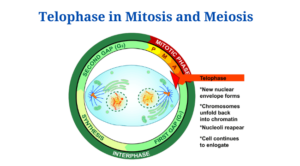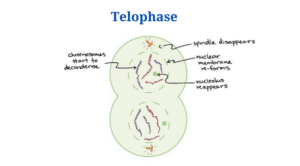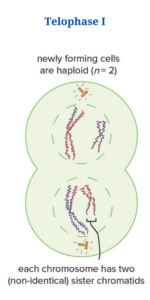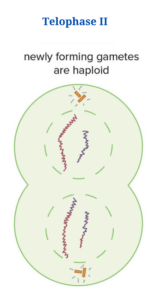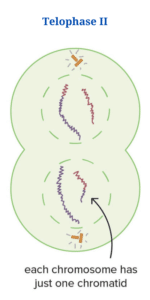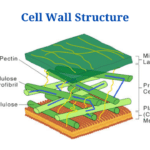What Exactly is Telophase?
Telophase is the fifth and last phase of mitosis, as well as the final phase of meiosis. Telophase I and telophase II are the two phases of meiosis. This is the step in which duplicate genetic components carried in the parent cells’ cell nuclei are separated. They produce two identical daughter cells as a result. After replication, telophase begins when the paired chromosomes are split and dragged to opposing poles of the cell.
What Happens in Telophase?
The nuclear membrane forms surrounding each set of chromosomes during telophase. This divides the cytoplasm from the nuclear DNA. The chromosomes subsequently begin to uncoil, becoming less compact and dispersed. This is followed by cytokinesis, which separates the parent cell’s cytoplasm into two daughter cells.
Telophase in Mitosis
The dephosphorylation of the mitotic cyclin-dependent kinase (CDK) substrate controls telophase in mitosis, which is a major extension of anaphase and metaphase. This phase is characterised by a number of mechanisms that result in the production of new daughter cells. These are some of them:
The mitotic Cyclin-Dependent Kinase substrate is dephosphorylated (Cdk)
- In the early stages of mitosis, phosphorylation of the mitotic Cyclin-dependent Kinase substrate causes spindle construction, chromosomal condensation, and nuclear envelope collapse.
- In telophase, the mitotic cell cycle comes to a conclusion, and dephosphorylation occurs. This permits the spindles to be disassembled, the nuclear membrane to be repaired, and new daughter cells to have their chromosomes condensed. Cdc-14, one of the most important Cdks, is activated by being released into the nucleus from the nucleolus and then exported to the cytoplasm.
- Its initial function is to stabilise the mitotic spindles and release more Cdc-14 into the nucleus, where it becomes limited, during the early phases of anaphase.
- During telophase, the restriction in the nucleus is noticed when it plays a key function in the Mitotic Exit Network (MEN), where it promotes spindle disassembly and nuclear envelope assembly.
- It also mediated dephosphorylation by activating telophase-specific downstream regulatory proteins including CHD1 dephosphorylation proteins, which target proteolysis and eventually lead to cellular switching activity and the G1 phase of interphase.
- Dephosphorylation also leads to:
- Distancing of chromosomes from the metaphase plate, causing early telophase, is also a result of dephosphorylation.
- Cdc48 also activates ubiquitination in the proteasomes, which drives telophase events such as spindle disassembly, nuclear envelope assembly, and chromosomal condensation.
Disassembly of the mitotic spindle
- The kinetochore microtubules shorten, dragging the chromosomes to the cell poles and detaching them from the chromosomes.
Reassembly of the nuclear envelop
- The inner nuclear membrane is formed through the repair of the double nuclear membrane, the development of nuclear pore complexes, and the integration of the internal nuclear lamina.
- During the prophase and metaphase phases, these organelles are destroyed.
- During metaphase, the nuclear membrane is absorbed by the endoplasmic membrane, but during telophase, the nuclear membrane protein-containing vesicles of the endoplasmic reticulum are targeted to the chromatins. The creation of the nuclear envelope and the double-layered nuclear membrane is influenced by this.
Click Here for Complete Biology Notes
Condensation of chromosomes
- Expanded chromatin is formed by chromosome condensation (decompaction). The compact chromosomes are required for cell preparation and interphase commencement.
- Condensation occurs in tandem with the construction of the nuclear envelope, which is mediated by the dephosphorylation of the Mitotic-Exit Network (MEN) Cyclin-Dependent Kinase, which resumes the interphase.
Figure: Telophase in mitosis. Image Source: Khan Academy.
Summary of telophase in mitosis
- The final phase of mitosis is known as telophase.
- The processes are reversed from anaphase and metaphase, in which a new nuclear membrane is created, the chromosomes are unfolded into chromatins, the cell nucleoli resurface, and the cell begins to enlarge once more.
- The sister chromatids reach the cell’s opposite poles during this phase.
- At the conclusion of the cell, the little nuclear vesicles begin to reassemble around the chromosomes.
- The nuclear membrane reforms by tying up with the chromosomes, resulting in the formation of two nuclei in one of the new cells.
- The kinetochore microtubules are likewise destroyed during this phase, whereas the polar microtubules continue to elongate.
- The chromosomes begin to condense and become more diffuse when the nuclear membrane undergoes reformation
Telophase in Meiosis
Telophase I
- The homologous chromosomes split into distinct nuclei during telophase I.
- The cell reassembles its nuclear membrane, disassembles the spindle fibres, and enters cytokinesis.
- The cell then enters a phase of rest known as interkinesis.
Figure: Telophase I in meiosis. Image Source: Khan Academy.
Telophase II
- The sister chromatids of each chromosome are already separated at this point, and they are enclosed by a new nuclear membrane at this phase.
- Despite the fact that the cells share the same chromosome, differentiation occurs during recombination, in which a portion of the homologous chromosomes is exchanged in prophase 1.
- By the end of meiosis, four cells have been formed, each with two alleles for each gene that are separated in various ways while combining with alleles from other genes.
Figure: Telophase II in meiosis. Image Source: Khan Academy.
Citations
- https://www.ncbi.nlm.nih.gov/pmc/articles/PMC3501164/
- https://www.cell.com/cgi/content/full/117/3/361/DC1
- https://quizlet.com/118059230/the-cell-cycle-and-mitosis-flash-cards/
- https://owlcation.com/stem/Stages-of-the-Cell-Cycle-Mitosis-Part-2-of-2
- https://en.m.wikipedia.org/wiki/Telophase
- https://biologydictionary.net/telophase/
- https://biologydictionary.net/prophase/
- https://answers.yahoo.com/question/index?qid=20070515070459AATdqtH
- https://www.thoughtco.com/daughter-cells-defined-4024745
- https://www.sparknotes.com/biology/cellreproduction/mitosis/section3/
- https://www.sciencedirect.com/topics/biochemistry-genetics-and-molecular-biology/telophase
Related Posts
- Lineweaver–Burk Plot with Example
- Cell Wall: Definition, Diagram, Structure And Functions
- Phylum Porifera: Classification, Characteristics, Examples
- Dissecting Microscope (Stereo Microscope) Definition, Principle, Uses, Parts
- Epithelial Tissue Vs Connective Tissue: Definition, 16+ Differences, Examples
- 29+ Differences Between Arteries and Veins
- 31+ Differences Between DNA and RNA (DNA vs RNA)
- Eukaryotic Cells: Definition, Parts, Structure, Examples
- Centrifugal Force: Definition, Principle, Formula, Examples
- Asexual Vs Sexual Reproduction: Overview, 18+ Differences, Examples
- Glandular Epithelium: Location, Structure, Functions, Examples
- 25+ Differences between Invertebrates and Vertebrates
- Cilia and Flagella: Definition, Structure, Functions and Diagram
- P-value: Definition, Formula, Table and Calculation
- Nucleosome Model of Chromosome

